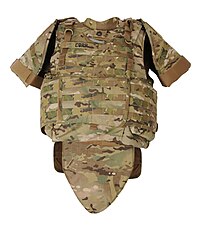
Photo from wikipedia
Abstract The ballistic response against small projectiles of a hybrid laminate made up of a front layer of a needle-punched nonwoven fabric and several layers of a woven fabric was… Click to show full abstract
Abstract The ballistic response against small projectiles of a hybrid laminate made up of a front layer of a needle-punched nonwoven fabric and several layers of a woven fabric was analyzed from the experimental and numerical viewpoint. The experimental results showed that the hybrid shield outperformed the woven and nonwoven counterparts in terms of the ballistic limit and of the energy dissipated, which was larger than the sum of the energies dissipated individually by the woven and nonwoven fabrics. Moreover, the energy absorption of the hybrid shield was maintained above the ballistic limit, leading to a ballistic performance similar to the one reported in fiber-reinforced composites. In fact, the hybrid polyethylene shield presented better impact performance than conventional laminates based on aramid woven fabrics with similar areal weight. The mechanisms responsible for the ballistic performance of the hybrid shield were ascertained by means of numerical simulations. The deformation and failure mechanisms obtained in the numerical simulations were in agreement with the experimental results and showed the complex interaction between the projectile, the nonwoven and the woven fabrics during impact which led to an enhanced energy absorption capability.
Journal Title: International Journal of Impact Engineering
Year Published: 2018
Link to full text (if available)
Share on Social Media: Sign Up to like & get
recommendations!